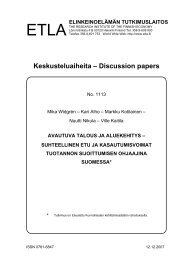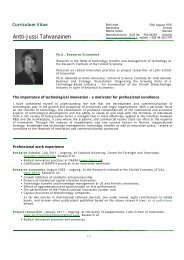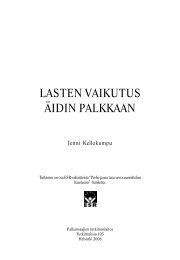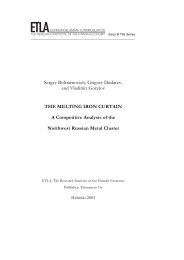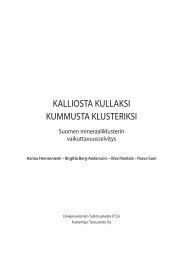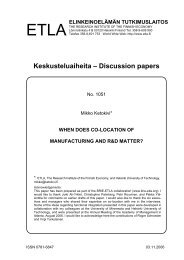Schooling, Family Background, and Adoption: Is it Nature or is ... - Etla
Schooling, Family Background, and Adoption: Is it Nature or is ... - Etla
Schooling, Family Background, and Adoption: Is it Nature or is ... - Etla
You also want an ePaper? Increase the reach of your titles
YUMPU automatically turns print PDFs into web optimized ePapers that Google loves.
are usually older than biological parents. Simple t-stat<strong>is</strong>tics indicate that<br />
w<strong>it</strong>h the exception of gender all the differences are significant; see column<br />
3, Table 7.<br />
W<strong>it</strong>h respect to family background variables we find significant differences<br />
too. Adopting families have on average fewer children. The structural<br />
differences in the socioeconomic character<strong>is</strong>tics of biologically related <strong>and</strong><br />
adopting families indicate that e<strong>it</strong>her adopting agencies <strong>or</strong> adopting families<br />
are selective. Adopting families turn out to be above average in all their<br />
socioeconomic character<strong>is</strong>tics. Note furtherm<strong>or</strong>e that although observed differences<br />
in individual <strong>and</strong> family character<strong>is</strong>tics are fav<strong>or</strong>able f<strong>or</strong> the human<br />
cap<strong>it</strong>al accumulation of adopted children the estimates in Table 5 show that<br />
adopted children remain w<strong>or</strong>se off w<strong>it</strong>h respect to years of schooling even<br />
when we control f<strong>or</strong> their fav<strong>or</strong>able individual <strong>and</strong> background character<strong>is</strong>tics.<br />
So far, two things have become clear. First, adopted <strong>and</strong> biological<br />
children structurally differ in their observables. Second, if adopted <strong>and</strong><br />
biological children structurally differ in their unobservables the nature <strong>and</strong><br />
nurture estimates suffer from abil<strong>it</strong>y bias. In most s<strong>it</strong>uations the bias points<br />
to overestimated nature effects. In fact, we can only think of two clear<br />
selectiv<strong>it</strong>y effects where our her<strong>it</strong>abil<strong>it</strong>y estimate <strong>is</strong> too low: (i) if adoption<br />
agencies use c<strong>or</strong>responding qual<strong>it</strong>ies of both natural <strong>and</strong> adoptive parents<br />
as a matching strategy, <strong>and</strong> (ii) if parents invest m<strong>or</strong>e time <strong>and</strong> money<br />
in adopted children. In the remainder of th<strong>is</strong> Section, we will argue (<strong>and</strong><br />
test) that these two s<strong>it</strong>uations are not fully applicable, <strong>and</strong> that our nurture<br />
estimate of 20 to 35 percent turns out to be a rather conservative estimate.<br />
Do adoption agencies use matching strategies based on similar<strong>it</strong>ies between<br />
adopted child <strong>and</strong> adoptive parents, <strong>and</strong> select theref<strong>or</strong>e families w<strong>it</strong>h<br />
relatively less fav<strong>or</strong>able socio-economic backgrounds? In Table 8 we test<br />
whether adoption families are r<strong>and</strong>omly drawn from the population at large.<br />
We find that adoption agencies are not blind. Estimates of simple log<strong>it</strong> models<br />
indicate that the chances of a household being adoptive r<strong>is</strong>e especially<br />
when the mother <strong>is</strong> m<strong>or</strong>e educated. Parental IQ does not matter. F<strong>or</strong> our<br />
exerc<strong>is</strong>e th<strong>is</strong> result <strong>is</strong> f<strong>or</strong>tunate, but not unexpected. Agencies do not have<br />
inf<strong>or</strong>mation on the IQ levels of adopting parents. Note that we are aware<br />
that these log<strong>it</strong>s are reduced f<strong>or</strong>m models <strong>and</strong> can also be interpreted as<br />
if adoption families select themselves–but if so, one would have expected a<br />
m<strong>or</strong>e prominent role of IQ. Since <strong>it</strong> <strong>is</strong> not clear whether agencies use the<br />
described matching procedures, <strong>and</strong> since IQ effects are fairly small the resulting<br />
bias <strong>is</strong> probably not substantial.<br />
22





